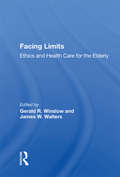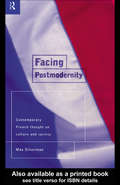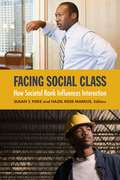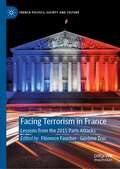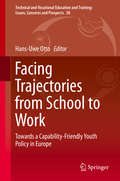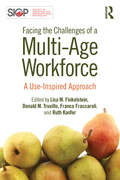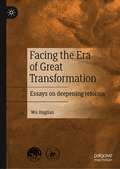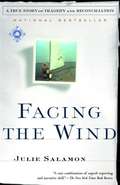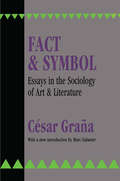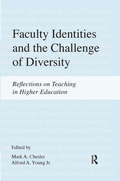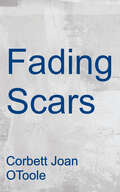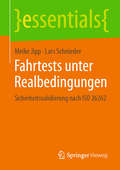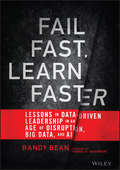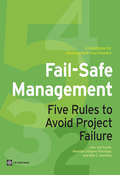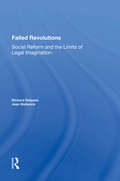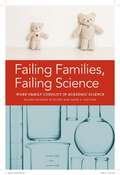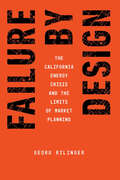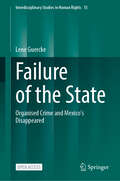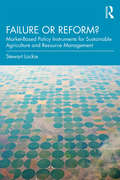- Table View
- List View
Facing An Unequal World: Challenges for Global Sociology (SAGE Studies in International Sociology)
by Raquel Sosa ElízagaSociology in the modern world faces many challenges. This edited volume explores significant themes including inequality, structures of power, conceptions of justice and sustainable futures, forming a critical examination across twenty-five individually authored chapters. This text forms part of SAGE Studies in International Sociology series (SSIS).
Facing Limits: Ethics And Health Care For The Elderly
by Gerald R. Winslow James W. WaltersAdvances in medical technology and the rapidly increasing population of older Americans are causing people to question the ethical limits of life-extending interventions. How do we weigh issues involving equity, efficiency, autonomy, natural life span, and responsibility for the financial burdens of health care for the elderly? In this collection o
Facing Postmodernity: Contemporary French Thought
by Max SilvermanFacing Postmodernity explains French cultural theory by grounding it in the politics of the issues facing France today such as: * the breaking of the city * racism * the crisis of culture * new citizenship. It discusses some of the major responses to postmodernity by contemporary French thinkers, both the very well known -Lyotard, Levinas, Derrida - and those who will be less familiar to a non-French audience. In doing so, it addresses the questions central to the postmodern debate whatever country it takes place in; questions of history, of representation, identity and community.
Facing Social Class: How Societal Rank Influences Interaction
by Hazel Rose Markus Susan T. FiskeMany Americans, holding fast to the American Dream and the promise of equal opportunity, claim that social class doesn't matter. Yet the ways we talk and dress, our interactions with authority figures, the degree of trust we place in strangers, our religious beliefs, our achievements, our senses of morality and of ourselves--all are marked by social class, a powerful factor affecting every domain of life. In Facing Social Class, social psychologists Susan Fiske and Hazel Rose Markus, and a team of sociologists, anthropologists, linguists, and legal scholars, examine the many ways we communicate our class position to others and how social class shapes our daily, face-to-face interactions--from casual exchanges to interactions at school, work, and home. Facing Social Class exposes the contradiction between the American ideal of equal opportunity and the harsh reality of growing inequality, and it shows how this tension is reflected in cultural ideas and values, institutional practices, everyday social interactions, and psychological tendencies. Contributor Joan Williams examines cultural differences between middle- and working-class people and shows how the cultural gap between social class groups can influence everything from voting practices and political beliefs to work habits, home life, and social behaviors. In a similar vein, Annette Lareau and Jessica McCrory Calarco analyze the cultural advantages or disadvantages exhibited by different classes in institutional settings, such as those between parents and teachers. They find that middle-class parents are better able to advocate effectively for their children in school than are working-class parents, who are less likely to challenge a teacher's authority. Michael Kraus, Michelle Rheinschmidt, and Paul Piff explore the subtle ways we signal class status in social situations. Conversational style and how close one person stands to another, for example, can influence the balance of power in a business interaction. Diana Sanchez and Julie Garcia even demonstrate that markers of low socioeconomic status such as incarceration or unemployment can influence whether individuals are categorized as white or black--a finding that underscores how race and class may work in tandem to shape advantage or disadvantage in social interactions. The United States has one of the highest levels of income inequality and one of the lowest levels of social mobility among industrialized nations, yet many Americans continue to buy into the myth that theirs is a classless society. Facing Social Class faces the reality of how social class operates in our daily lives, why it is so pervasive, and what can be done to alleviate its effects.
Facing Terrorism in France: Lessons from the 2015 Paris Attacks (French Politics, Society and Culture)
by Gérôme Truc Florence FaucherFrom 2015, Europe was hit by a new wave of terrorist attacks, coordinated or supported by an international Islamist organization (ISIS) but sometimes also perpetrated by citizens of the targeted country: the attacks on Paris, Brussels, London, Manchester, Nice and Barcelona probably attracted most attention but the most dramatic were perpetrated in Paris, in January and November 2015. These events shook the foundations of French society not only because of their magnitude but also because of the symbolic nature of the targets. Whilst in January, the targets were carefully selected as emblematic of France (the satirical weekly Charlie Hebdo, the police forces, the Jewish community) and of European liberal values (journalists and cartoonists), in November the victims ordinary people enjoying music, sports and restaurants. The book offers a unique interdisciplinary investigation into the complex responses of French society: from the individual level (survivors of the Bataclan attack, emotional citizens paying homage to the victims, French Muslims) to the meso level of civic association and web communities, and the macro level of the State and public opinion.
Facing Trajectories from School to Work
by Jean-Michel Bonvin Hans-Uwe Otto Roland Atzmüller Thierry Berthet Lavinia Bifulco Enrica Chiappero-Martinetti Valerie Egdell Björn Halleröd Christian Christrup Kjeldsen Marek Kwiek Regine Schröer Josiane Vero Marianna ZieleńskaThis book promotes a radical alternative impact on youth policy in Europe to overcome the situation of vulnerability and discrimination of a growing number of youngsters in their transition from school to work. It follows a Human Development perspective in using the Capability Approach (CA) as analytical and methodological guiding tool to improve the social conditions of the most socially vulnerable young people in European societies. The mission of the interdisciplinary authors is to expand the actual chances of the young to actively shape their lives in a way they have reason to choose and value. This book is based on the research of the EU Collaborative Project "Making Capabilities Work" (WorkAble), funded by the EU within the Seventh Framework Programme. It is the first empirical project to pursue a justice theory perspective on a European level. It also contributes to a fundamental change in the currently mostly insufficient attempts within the human capital approach to use the labour market to ensure desired lifestyle forms and a secure income for vulnerable youth.
Facing Up to the American Dream: Race, Class, and the Soul of the Nation (Princeton Studies in American Politics: Historical, International, and Comparative Perspectives #51)
by Jennifer L. HochschildThe ideology of the American dream--the faith that an individual can attain success and virtue through strenuous effort--is the very soul of the American nation. According to Jennifer Hochschild, we have failed to face up to what that dream requires of our society, and yet we possess no other central belief that can save the United States from chaos. In this compassionate but frightening book, Hochschild attributes our national distress to the ways in which whites and African Americans have come to view their own and each other's opportunities. By examining the hopes and fears of whites and especially of blacks of various social classes, Hochschild demonstrates that America's only unifying vision may soon vanish in the face of racial conflict and discontent. Hochschild combines survey data and vivid anecdote to clarify several paradoxes. Since the 1960s white Americans have seen African Americans as having better and better chances to achieve the dream. At the same time middle-class blacks, by now one-third of the African American population, have become increasingly frustrated personally and anxious about the progress of their race. Most poor blacks, however, cling with astonishing strength to the notion that they and their families can succeed--despite their terrible, perhaps worsening, living conditions. Meanwhile, a tiny number of the estranged poor, who have completely given up on the American dream or any other faith, threaten the social fabric of the black community and the very lives of their fellow blacks. Hochschild probes these patterns and gives them historical depth by comparing the experience of today's African Americans to that of white ethnic immigrants at the turn of the century. She concludes by claiming that America's only alternative to the social disaster of intensified racial conflict lies in the inclusiveness, optimism, discipline, and high-mindedness of the American dream at its best.
Facing the Challenges of a Multi-Age Workforce: A Use-Inspired Approach (SIOP Organizational Frontiers Series)
by Lisa M. Finkelstein Franco Fraccaroli Donald M. Truxillo Ruth KanferFacing the Challenges of a Multi-Age Workforce examines the shifting economic, cultural, and technological trends in the modern workplace that are taking place as a result of the aging global workforce. Taking an international perspective, contributors address workforce aging issues around the world, allowing for productive cross-cultural comparisons. Chapters adopt a use-inspired approach, with contributors proposing solutions to real problems faced by organizations, including global teamwork, unemployed youth, job obsolescence and over-qualification, heavy emotional labor and physically demanding jobs, and cross-age perceptions and communication. Additional commentaries from sociologists, gerontologists, economists, and scholars of labor and government round out the volume and demonstrate the interdisciplinary nature of this important topic.
Facing the Era of Great Transformation: Essays on deepening reforms
by Wu JinglianThis book collects essays from Chinese economic sage who was the mastermind of the reform and opening and persistent champion of market-driven development. In the essays, he outlines his vision of the systemic reform needed for today's China, from rule of law to completion of the market system and reform of state-owned enterprises. Dr. Wu's thoughts are always of interest, but at this pivotal moment of Chinese economic recalibration, his views will be of more value than ever, to scholars, economists, journalists, and those in civil society.
Facing the Wind: A True Story of Tragedy and Reconciliation
by Julie SalamonIn 1978 Robert Rowe, a Brooklyn attorney, murdered his wife and three children; his 12-year-old son Christopher was blind and had multiple disabilities. Three years earlier Rowe had been diagnosed with psychotic depression. He was acquitted of the murders on the insanity plea. After two years in a psychiatric hospital he was released and set out to build a new life. Salamon bases her book on extensive interviews with the people who knew Rowe and his family. Key among them are the members of a support group for mothers of blind children. The attitudes of the mothers, as conveyed by Salamon, are highly negative toward blind people, and the children are consistently portrayed as burdensome to their parents. On the plus side, the book raises probing questions about the nature of guilt and atonement, sanity and madness, and the meaning of forgiveness.
Fact and Prejudice: How to Communicate with Esoterics, Fanatics and Conspiracy Believers
by Holm Gero Hümmler Ulrike SchiesserWhen having coffee with your family, you are offered energized water. On Twitter you discuss with vaccination opponents. The WhatsApp kitagroup discusses zodiac signs, the pharmacy sells you globules, the neighbor proselytizes for her guru, and the news is once again about demonstrations by right-wing extremists.Everywhere you encounter conspiracy myths, superstition, esotericism, pseudoscience and Co. and you want to respond to them - while remaining as factual as possible, clarify your position, provide facts, but also not unnecessarily provoke or overload. In addition, you do not want to hurt your counterpart, but to encourage him to rethink. But how do you do that?If you are asking yourself this question, read "Fact and Prejudice". Understand why we are driven by emotions and most information bounces off us. Read experiences and tips from interviews with professional (science) communicators. Then follow different people through their own rethinking processes: What convinces an alternative medicine practitioner to leave non-evidence-based medicine behind? What was the deciding factor for a former vaccination opponent to have her children vaccinated after all? What helps members of appropriative organizations to get out? What moves a celebrated medium to break away from esotericism?This book is for anyone who worries about or doesn't know how to communicate with people who have irrational worldviews - whether it's with family, friends, anonymously on the Internet, or at work. The authors give concrete tips on discussions and situations and also help to decide when it is important to engage and when it is better to withdraw.
Fact and Symbol: Essays in the Sociology of Art and Literature
by Marc Galanter César GrañaCesar Grafla's work critically examines the continual rebirth of cultural romances on the part of literaiy Intellectuals. Grafia's disdain for contrived rejections of modernity and for grand destructive gestures is combined with his intense appreciation of the romantic sensibility. Fact and Symbol embodies Grafta’s views of the enterprise of cultural sociology in which both words are given equal play. This book consists of seven essays. Five shorter pieces on the relation of art to American democracy are bracketed by two long essays, the first on the literaiy critique of modern life, the last on Spanish American cultural nationalism. Among the temes covered throughout the book are attitudes prevalent during the post-romantic era, the French impressionists, art museums, the transformation of the industrial and commercial elite of America, and Spanish-American literary Utopians. In a new Introduction, written especially for this edition, Marc Galanter outlines Graiia’s ideas and explains what he was aiming to do when he originally wrote these essays. Fact and Symbol presents Graiia’s unique viewpoint and will be enjoyed by scholars of art and literature, as well as sociologists. One can well appreciate why this book was nominated for a National Book Award on its original release. It is a pioneering achievement in the sociology of culture.
Factor Analysis: Classic Edition (Psychology Press & Routledge Classic Editions)
by Richard L. GorsuchComprehensive and comprehensible, this classic text covers the basic and advanced topics essential for using factor analysis as a scientific tool in psychology, education, sociology, and related areas. Emphasizing the usefulness of the techniques, it presents sufficient mathematical background for understanding and applying its use. This includes the theory as well as the empirical evaluations. The overall goal is to show readers how to use factor analysis in their substantive research by highlighting when the differences in mathematical procedures have a major impact on the substantive conclusions, when the differences are not relevant, and when factor analysis might not be the best procedure to use. Although the original version was written years ago, the book maintains its relevance today by providing readers with a thorough understanding of the basic mathematical models so they can easily apply these models to their own research. Readers are presented with a very complete picture of the "inner workings" of these methods. The new Introduction highlights the remarkably few changes that the author would make if he were writing the book today. An ideal text for courses on factor analysis or as a supplement for multivariate analysis, structural equation modeling, or advanced quantitative techniques taught in psychology, education, and other social and behavioral sciences, researchers who use these techniques also appreciate this book’s thorough review of the basic models. Prerequisites include a graduate level course on statistics and a basic understanding of algebra. Sections with an asterisk can be skipped entirely if preferred.
Faculty Identities and the Challenge of Diversity: Reflections on Teaching in Higher Education
by Mark A Chesler Alford A Young JrThis book examines the undergraduate teaching experiences and collegial relationships of university faculty who hold appointments in social science, humanities, or natural science and engineering, and who have received undergraduate teaching or service-to-diversity nominations and awards. Documenting and interpreting faculty members' social identities and pedagogical practices, Faculty Identities and the Challenge of Diversity explores how professors address the diverse racial, ethnic, gender, and sexual identities of their students. By carefully considering how this unique group of faculty makes sense of their instruction and classrooms, this book provides practical advice that will prove beneficial to both experienced and new teachers looking to improve their practice in a changing educational landscape.
Fading Scars: My Queer Disability History
by Corbett Joan Otoole Chun-Shan Sandie Yi By PhotographerEver wondered: Where do people have sex when occupying a federal building? How the disability rights movement got saved by the Black Panther Party? What is important to queer disabled people? Fading Scars answers these questions and many more. <p><p>Discover hundreds of insider stories about disabled parenting, sports, culture, racism, creating civil rights for disabled Americans, and much more. These essays explore the intersections of disability with sex, gender, race, and class through stories of struggle and triumph. A story about alliances and friendships and care and love. It tells us that we are all part of a history in the making and in the past. It is disability history, an American story, a world story, and our story. - Karen Nakamura, professor, University of California Berkeley <p><p>She takes us on a wild ride through women's movements, creating disability rights, pride and resilience. Her compelling stories are infused with humor and wisdom that challenges your assumptions and opens your heart.
Fahren auf nächtlichen Straßen unterschiedlicher Helligkeit (Verkehrspsychologie)
by Christoph SchulzeDem nächtlichen Straßenverkehr kommt eine hohe Bedeutung zu, wobei die Sichtbedingungen und deren technische Unterstützung durch künstliche Beleuchtung zentral sind. Ein Großteil der wissenschaftlichen Diskussion in diesem Bereich beschäftigt sich mit der Sichtbarkeit von mehr oder weniger definierten Einzelobjekten, oft vor einem anlassbezogenen Hintergrund der Verkehrssicherheit. Die vorliegende Arbeit widmet sich dem weit seltener beforschten, unter Praxisgesichtspunkten jedoch höchst relevanten, regelmäßig stattfindenden nächtlichen Fahrverhalten und untersucht, welchen Einfluss das Helligkeitsniveau (nächtliche Fahrbahnleuchtdichte) darauf hat. Ausgehend von einer heterogenen Theorien- und empirische Befundlage beforschen drei Fahrsimulatorstudien unter lichttechnisch kontrollierten Bedingungen den Zusammenhang bei unbeeinflusster Fahrt (verschiedene Voraussichtweiten und fahrregulatorische Anforderungen) sowie bei Manövern im Fahrprozess, die Teil der permanenten Längs- und Querführung sind (Übergänge Gerade zu Kurve) oder eher singulären Charakter haben (Fahrstreifenwechsel). Im Ergebnis wird ein bedeutsamer Einfluss des nächtlichen Helligkeitsniveaus von Straßen auf das regelmäßige Fahren belegt und ein Beitrag zur Klärung der diesbezüglich heterogenen Literaturlage geleistet.
Fahrradpiktogramme auf der Fahrbahn: Ein Beitrag zu Flächengerechtigkeit und Verkehrssicherheit in beengten Verhältnissen (Verkehrspsychologie)
by Stefanie RufFahrradpiktogramme auf der Fahrbahn können genutzt werden, um Radfahrende in beengten Verhältnissen auf ihr Recht, auf der Fahrbahn zu fahren, aufmerksam zu machen. Gleichzeitig dienen sie als Hinweis für Kfz-Fahrende, auf Radfahrende auf der Fahrbahn vorbereitet zu sein und diesen rücksichtsvoll zu begegnen. International sind sicherheitsförderliche Effekte der Maßnahmen gut belegt, eine Untersuchung im deutschen Verkehrskontext stand bisher jedoch noch aus. Stefanie Ruf begleitet die Umsetzung von Piktogrammen in verschiedenen deutschen Kommunen mit Vorher-Nachher-Befragungen im Feld sowie mit einer ergänzenden kontrollierten Online-Befragung. Ihre Erkenntnisse zeigen, dass Fahrradpiktogramme auf der Fahrbahn auch in Deutschland einen Beitrag zu Flächengerechtigkeit und Verkehrssicherheit leisten können, gleichzeitig werden auch wichtige Einschränkungen diskutiert.
Fahrtests unter Realbedingungen: Sicherheitsvalidierung nach ISO 26262 (essentials)
by Lars Schnieder Meike JippFahrerassistenz, Fahrzeugautomation und vernetzte Systeme beschreiben die Zukunft der Automobilität und schüren die Erwartung essentiell verbesserter Verkehrssicherheit. Meike Jipp und Lars Schnieder verknüpfen eine ingenieurmäßige Sichtweise, die durch funktionale Sicherheit (ISO 26262:2018) und sichere Sollfunktion (ISO/PAS 21448:2019) geprägt ist, mit der Perspektive der Ingenieurpsychologie, die mithilfe sozialwissenschaftlicher Methoden menschzentrierte Automobilität sicher zu gestalten versucht. Der Mensch wird je nach Automationsgrad als Rückfallebene mit im Gesamtsystem berücksichtigt und auch zukünftig bei der Gestaltung vernetzter Systeme, die ihr Verhalten aufeinander abstimmen, eine zentrale Rolle spielen.Die Autoren: Prof. Dr. Meike Jipp forscht am Deutschen Zentrum für Luft- und Raumfahrt (DLR) e.V. im Institut für Verkehrssystemtechnik. Dr.-Ing. Lars Schnieder ist als Geschäftsführer einer Software-Entwicklungsfirma für das Geschäftsfeld Sicherheitsbegutachtung verantwortlich.
Fail Fast, Learn Faster: Lessons in Data-Driven Leadership in an Age of Disruption, Big Data, and AI
by Randy BeanExplore why — now more than ever — the world is in a race to become data-driven, and how you can learn from examples of data-driven leadership in an Age of Disruption, Big Data, and AI In Fail Fast, Learn Faster: Lessons in Data-Driven Leadership in an Age of Disruption, Big Data, and AI, Fortune 1000 strategic advisor, noted author, and distinguished thought leader Randy Bean tells the story of the rise of Big Data and its business impact – its disruptive power, the cultural challenges to becoming data-driven, the importance of data ethics, and the future of data-driven AI. The book looks at the impact of Big Data during a period of explosive information growth, technology advancement, emergence of the Internet and social media, and challenges to accepted notions of data, science, and facts, and asks what it means to become "data-driven." Fail Fast, Learn Faster includes discussions of: The emergence of Big Data and why organizations must become data-driven to survive Why becoming data-driven forces companies to "think different" about their business The state of data in the corporate world today, and the principal challenges Why companies must develop a true "data culture" if they expect to change Examples of companies that are demonstrating data-driven leadership and what we can learn from them Why companies must learn to "fail fast and learn faster" to compete in the years ahead How the Chief Data Officer has been established as a new corporate profession Written for CEOs and Corporate Board Directors, data professional and practitioners at all organizational levels, university executive programs and students entering the data profession, and general readers seeking to understand the Information Age and why data, science, and facts matter in the world in which we live, Fail Fast, Learn Faster p;is essential reading that delivers an urgent message for the business leaders of today and of the future.
Fail-Safe Management: Five Rules to Avoid Project Failure
by Jody Zall Kusek Marelize Goergens Prestidge Billy C. HamiltonThe decision to look at failures for answers is a bold one. Policy makers, planners and implementers have a tendency to look through prisms of success in framing working policies, programs and results when justifying them. Despite this, we still tend to address failures indirectly by looking at risk, critical success factors, unintended outcomes or consequences, and negative impacts to name a few. As the authors say, 'while success is desirable and we plan for it, failures are inevitable and we seldom plan to mitigate them. 'The authors have clearly emphasized the need to look at failures in an integrated manner by building them into the planning and budget process while at the same time identifying monitoring points for early detection that will provide critical information for timely intervention. Failures are real, and we must plan to face them when they emerge. This book will offer the necessary insight to managers. - Koshy Thomas, Head of the Outcome-based Budgeting Project Team, Ministry of Finance, MalaysiaThis book provides invaluable guidance on how to avoid the failure of interventions, whether for projects, programs, or policies. The authors note that although good design is essential, 'paying attention to details that only happen during implementation is essential in avoiding failure'. The five steps outlined are salutary, and point to the craft needed for good implementation-the range of issues which have continuously to be managed, the environment, stakeholders, resources, systems, and so on. As the authors point out, some elements are beyond the control of a project manager, but all too often it is the things that are controllable that are ignored at our peril. Good management is not sexy, but it usually makes thedifference between failure and success. This book deserves careful study by public and private sector managers and implementers. - Dr. Ian Goldman, Head of Evaluation and Research, Department of Performance Monitoring and Evaluation, The Presidency, South AfricaFail-Safe Management provides much needed guidance aimed at preventing failure in program implementation. Considerable resources and effort are traditionally invested in the development and scientific evaluation of program interventions. Despite the availability of efficaciousinterventions, population-level programmatic impact is difficult to achieve. The gap between the availability of scientifically developed efficacious interventions and the scarcity of population-level programmatic impact is often attributable to inadequate strategic planning and implementation failures. This book promises to be of great help to program managers in avoiding the latter. - Dr Sevgi Aral, Associate Director for Science, Division of STD Prevention, U. S. Centers for Disease Control and Prevention (CDC)During the discussions on the Lagos Plan of Action, the late President of The United Republic of Tanzania, Mwalimu Julius Nyerere asked, 'why projects in Africa failed and what can be done to rescue the situation'. The answer was that projects failed because of corruption and greed, and the solution suggested was to set up anti-corruption commissions to root out corrupt practices. Decades later the problem remains. What then is the problem? This book sheds light on why projects fail and provides a critical path on 'how to avoid failure' while addressing inevitable development problems. It outlines five simple steps-that are not rocket science-for development practitioners to understand and apply. Perhaps this book should have written at the time of Mwalimu Julius Nyerere and the Lagos Plan of Action. He would have found the right answers in it. - Dr. Simon Muchiru, Director, Oakwood and Associates Consultants, Gaborone, Botswana
Failed Revolutions: Social Reform And The Limits Of Legal Imagination
by Richard DelgadoForty years after school integration became the law of the land, African-American poverty, isolation, and despair are as deep as ever. Thirty years after the environmental revolution of the 1960s, our environment continues to deteriorate. Why have these and so many other hopeful revolutions failed? Focusing on the crucial discipline of the law,
Failing Families, Failing Science: Work-Family Conflict in Academic Science
by Elaine Ecklund Anne E. LincolnWork life in academia might sound like a dream: summers off, year-long sabbaticals, the opportunity to switch between classroom teaching and research. Yet, when it comes to the sciences, life at the top U.S. research universities is hardly idyllic. Based on surveys of over 2,000 junior and senior scientists, both male and female, as well as in-depth interviews, Failing Families, Failing Science examines how the rigors of a career in academic science makes it especially difficult to balance family and work.Ecklund and Lincoln paint a nuanced picture that illuminates how gender, individual choices, and university and science infrastructures all play a role in shaping science careers, and how science careers, in turn, shape family life. They argue that both men and women face difficulties, though differently, in managing career and family. While women are hit harder by the pressures of elite academic science, the institution of science—and academic science, in particular—is not accommodating, possibly not even compatible, for either women or men who want to raise families. Perhaps most importantly, their research reveals that early career academic scientists struggle considerably with balancing their work and family lives. This struggle may prevent these young scientists from pursuing positions at top research universities—or further pursuing academic science at all— a circumstance that comes at great cost to our national science infrastructure. In an era when advanced scientific research and education is more important than ever, Failing Families, Failing Science presents a compelling inside look at the world of the university scientists who make it possible—and what universities and national science bodies can do to make a difference in their lives.
Failure by Design: The California Energy Crisis and the Limits of Market Planning
by Georg RilingerA new framework for studying markets as the product of organizational planning and understanding the practical limits of market design. The Western energy crisis was one of the great financial disasters of the past century. The crisis began in April 2000, when price spikes started to rattle California’s electricity markets. Decades later, some blame economic fundamentals and ignorant politicians, while others accuse the energy sellers who raided the markets. In Failure by Design, sociologist Georg Rilinger offers a different explanation, one that focuses on the practical challenges of market design. The unique physical attributes of electricity made it exceedingly difficult to introduce markets into the coordination of the electricity system, so market designers were brought in to construct the infrastructures that coordinate how market participants interact. An exercise in social engineering, these infrastructures were intended to guide market actors toward behavior that would produce optimal market results and facilitate grid management. Yet, though these experts spent their days worrying about incentive misalignment and market manipulation, they unintentionally created a system riddled with opportunities for destructive behavior. Rilinger’s analysis not only illuminates the California energy crisis but also develops a broader theoretical framework for thinking about markets as the products of organizational planning and the limits of social engineering, contributing broadly to sociological and economic thinking about the nature of markets.
Failure of the State: Organised Crime and Mexico's Disappeared (Interdisciplinary Studies in Human Rights #15)
by Lene GuerckeThis Open Access book explores an issue that has received little attention in human rights research: organised criminal groups (OCGs) as perpetrators of human rights violations, especially disappearances. It takes an interdisciplinary approach, combining doctrinal legal research with a qualitative study on present-day disappearances in Mexico. Disappearances are a complex human rights violation that impacts not only the disappeared person but also their relatives, who are left in a limbo of uncertainty about their loved one’s fate. Originally part of state-led repression, today disappearances occur in varied contexts, often involving OCGs and other non-state actors. However, disappearances committed by non-state actors are not human rights violations under International Human Rights Law (IHRL), thereby potentially leaving a gap in the legal protection of victims. The book first analyses state obligations and case law involving state responsibility for human rights violations committed by non-state actors and applies the analysis to OCGs. This ‘internal’ legal perspective is complemented by an ‘external’ study based on interviews with human rights practitioners working on disappearances in Mexico, which often involve OCGs. The qualitative study offers a unique perspective on human rights protection ‘in reality’. The book adds to scholarship on non-state actors and disappearances, and to incipient international legal scholarship on the issue of organised crime and international law. Moreover, the study on Mexico provides a richer understanding of challenges faced by practitioners ‘on the ground’ where OCGs commit human rights violations alongside, or in collusion with, state forces and against the backdrop of an overall failure of the state. The book may be of interest to a diverse audience, including legal scholars and practitioners, human rights scholars in fields such as political science, international relations, or socio-legal studies, as well as funders supporting the work of NGOs in Mexico and similar contexts, and NGOs themselves.
Failure or Reform?: Market-Based Policy Instruments for Sustainable Agriculture and Resource Management
by Stewart LockieMarket reform promises more environmental protection and more profitable agriculture at lower financial cost. Too good to be true? This book examines numerous empirical examples of policy in action to identify principles for the successful application of market-based policy instruments. Where some market instruments are used to fix market failures by putting a value on environmental protection, others use market-like mechanisms to allocate financial incentives for environmental work. They are promoted as flexible, efficient and politically neutral solutions to the competing demands of social, economic and ecological sustainability. But they also attract criticism for rolling back environmental regulation and privatizing public goods. This book argues that while many market-based instruments have merit, decisions about responsibility cannot be left entirely to the market. Whichever instruments we use, decision-making needs to be embedded in a logic of democratization. Using case studies from around the world, this book investigates how instruments like eco-standards, payments for ecosystem services, pollution trading and community-based natural resource management perform in practice, and what can be learned about applying them more effectively. While the approach is primarily sociological, it is deliberately written to bridge the gap between sociology, economics, environmental sciences and the concerns of environmental policy makers.

